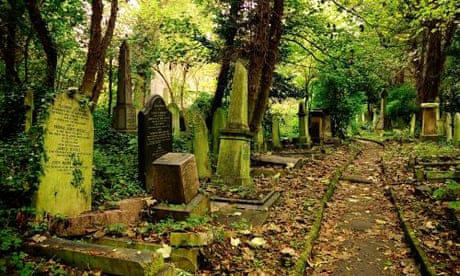 A funeral parlour in Glasgow: the most expensive place in the country for funerals is Beckenham in Kent. Photograph: Murdo Macleod for the Guardian
A funeral parlour in Glasgow: the most expensive place in the country for funerals is Beckenham in Kent. Photograph: Murdo Macleod for the GuardianHere’s a brainteaser – researchers have discovered something in the UK that has risen in cost almost as rapidly as house prices. What could it possibly be? A pint of craft beer? A university education? Your gas bill? Well, maybe. Look, I’m no economist. But, depressingly, the answer in this case is funerals.
According to the Royal London National Funeral Costs Index, prices have risen by 3.9% over the last year alone – that’s £140 in very real money, with a basic service costing £3,702. The research also noted that one in 10 people have struggled to pay for a funeral, ending up in debt, on average, to the tune of £1,318. Faced with rising costs, bereaved relatives are making cutbacks to basics – paying 11% less for coffins, for example. And alternative ceremonies are on the rise, with 8% of people opting for woodland or “natural” services.

Cost of dying outstrips inflation
Funerals are never far from the headlines. No living being is exempt from death. There is the growing trend for elaborate pet funerals, for example, which, it turns out, is a touchy subject for those who think that spending thousands of pounds on Fluffy’s send-off, complete with life-size statuary and bereavement counsellors, is perfectly fine – and more to the point, their prerogative. Which indeed it is, because with animals, you at least have options. Don’t fancy taking out a second mortgage? No problem. Cardboard box, back garden, job done. Alas, it’s not so easy with your loved ones.
However you look it, nearly £4,000 – and costs vary regionally, with Beckenham in Kent taking the prize for the most costly funeral, at £7,216 (no, I don’t know either) – is a massive amount to shell out for a party you’re not even going to be able to attend. And if you decide not to bother setting the cash aside, then all you’re doing is putting the financial burden on your nearest and dearest.
Of course, you could get round the problem by attending your own funeral. Yes, “living funerals” are a thing now. But the problem of your bona fide funeral, you know, when you’re actually dead, remains – unless at this point, because you’ve spunked all your cash on throwing your own (really weird) pre-death party, your loved ones just put you in a cardboard box and throw you in the ground.

How to do a funeral
We’ve also been introduced to the unlikely phrase “destination funerals”, with research showing that people are increasingly opting for an exciting and less sombre exit from this mortal coil. These funerals, complete with motorbikes and fancy dress for the non-mournful mourners speak to me of our increasing discomfort with what my therapist called “difficult feelings”. If we can’t allow ourselves to feel sad when someone is dead, when can we? Are we saving all our ire for the plastic bag tax? Funerals are supposed to be sombre – that’s the whole point. When I was diagnosed with breast cancer I planned my funeral (surprisingly satisfying) and let me tell you, it will be really, really upsetting. Wear black and bring a hanky.
But sad or not, “destination” or not, attended by you alive – or as is more common – dead, everyone must have a funeral. Costs are expected to rise further, with a shortage of burial space cited as one reason for the high fees. In Scotland, ministers have convened a committee to look into the issue. So it seems that funerals may increasingly resemble weddings – costs spiralling out of control, pressure to be “destination”, “fun” and “individual’, full of crap you don’t want or need, and their true meaning diminished.
Funeral poverty is a reality in Britain today. Those that have the cash can pay for a byzantine affair complete with a jazz band, a burial cake and piles of floral tributes. Those that don’t will be buried by their local authority. Unlike with weddings, you can’t opt out.

Cost of dying outstrips inflation
Funerals are never far from the headlines. No living being is exempt from death. There is the growing trend for elaborate pet funerals, for example, which, it turns out, is a touchy subject for those who think that spending thousands of pounds on Fluffy’s send-off, complete with life-size statuary and bereavement counsellors, is perfectly fine – and more to the point, their prerogative. Which indeed it is, because with animals, you at least have options. Don’t fancy taking out a second mortgage? No problem. Cardboard box, back garden, job done. Alas, it’s not so easy with your loved ones.
However you look it, nearly £4,000 – and costs vary regionally, with Beckenham in Kent taking the prize for the most costly funeral, at £7,216 (no, I don’t know either) – is a massive amount to shell out for a party you’re not even going to be able to attend. And if you decide not to bother setting the cash aside, then all you’re doing is putting the financial burden on your nearest and dearest.
Of course, you could get round the problem by attending your own funeral. Yes, “living funerals” are a thing now. But the problem of your bona fide funeral, you know, when you’re actually dead, remains – unless at this point, because you’ve spunked all your cash on throwing your own (really weird) pre-death party, your loved ones just put you in a cardboard box and throw you in the ground.

How to do a funeral
We’ve also been introduced to the unlikely phrase “destination funerals”, with research showing that people are increasingly opting for an exciting and less sombre exit from this mortal coil. These funerals, complete with motorbikes and fancy dress for the non-mournful mourners speak to me of our increasing discomfort with what my therapist called “difficult feelings”. If we can’t allow ourselves to feel sad when someone is dead, when can we? Are we saving all our ire for the plastic bag tax? Funerals are supposed to be sombre – that’s the whole point. When I was diagnosed with breast cancer I planned my funeral (surprisingly satisfying) and let me tell you, it will be really, really upsetting. Wear black and bring a hanky.
But sad or not, “destination” or not, attended by you alive – or as is more common – dead, everyone must have a funeral. Costs are expected to rise further, with a shortage of burial space cited as one reason for the high fees. In Scotland, ministers have convened a committee to look into the issue. So it seems that funerals may increasingly resemble weddings – costs spiralling out of control, pressure to be “destination”, “fun” and “individual’, full of crap you don’t want or need, and their true meaning diminished.
Funeral poverty is a reality in Britain today. Those that have the cash can pay for a byzantine affair complete with a jazz band, a burial cake and piles of floral tributes. Those that don’t will be buried by their local authority. Unlike with weddings, you can’t opt out.
No comments:
Post a Comment